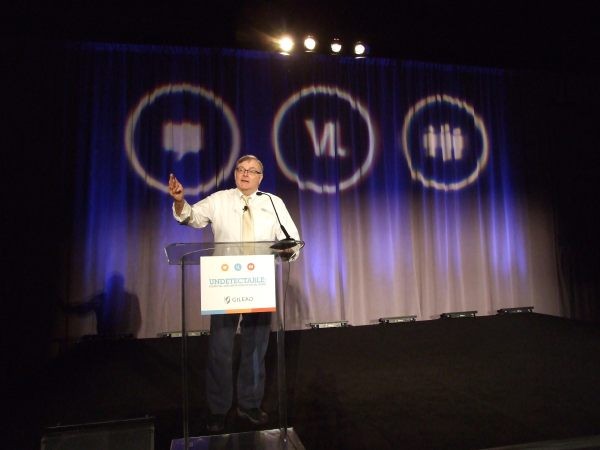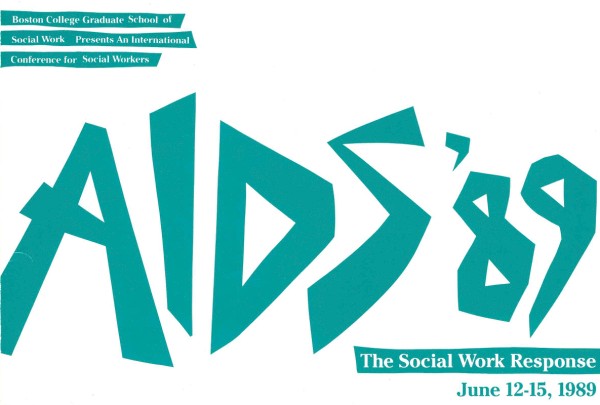
Lynch addresses the 2014 AIDS: The Social Work Response conference in Denver.
This coming May 26-29, BCSSW’s Director of Continuing Education Vincent Lynch will chair the 28th annual National Conference on Social Work and HIV/AIDS. It will be held in Minneapolis, Minnesota and will focus on the theme “This is what we are all about: champions for HIV care.”
Lynch founded the Social Work and AIDS conference in 1988. In addition to organizing and chairing every one of the conferences, he has become a leader in the field, editing four books on social workers and HIV/AIDS, and providing immeasurable support to many colleagues and peers. While he plans to retire later this year, Lynch hopes that the conference will remain an important event for years to come, as Collaborative Solutions, Inc., Birmingham, AL will take over the leadership moving forward.
Recently, Lynch sat down with Innovate to discuss the history of the conference and its critical role in social work higher education over the past nearly three decades.
Thanks for taking the time to speak with us today. This will be your 28th year in charge of this remarkable event that has served such an important role for the community of social workers in our country, and abroad. Take us back to the founding year, 1988, and how it all began.
Vincent Lynch: Actually, I stumbled upon the idea. I had been the Director of Continuing Education at BC Social Work since 1986. I was conducting a needs assessment for our community. I met with six social workers at AIDS Action in Boston, and I learned how hard their work was. There was no treatment for AIDS at that time, but also, there was very little information for social workers to draw from to help them provide services to those living with the disease.
The group was very frustrated about this lack of information, and despite repeated requests to various organizations within the field, they felt left out in the cold. So it fast became clear to me that there was an unmet need. I didn’t know anything about AIDS at the time, but I did know how to run a conference, so I offered to do just this, and the rest is history, as they say.
Tell us about that first conference. I believe it was held on the campus of Boston College.
VL: It was! Initially, we thought that the conference was going to be a one-time thing, but as the word got out that BC was doing something in this area, we began to receive inquiries from around the world. A one-day event turned into a four-day event with more than 100 presentations, so we decided to take the requisite lead-time to make an event of this magnitude happen. Thus, AIDS ’89: The Social Work Response took place on June 12-15, 1989. We had 418 attendees from over 40 states and at least 15 countries worldwide. Our general sessions were held at Robsham Theater, with breakout sessions in McGuinn Hall.

The cover of the brochure for the inaugural conference in 1989.
It was such a success that immediately we were flooded with feedback asking us to do a second conference. So we did, at San Jose State University, and following similar positive feedback and levels of response that year, we decided to make it an annual event. And here we are, 28 years later, getting ready to convene in Minneapolis.
Take us through a brief history of the conference, if you would, and how it has mirrored the history of AIDS in our world.
VL: I’m actually writing a book chapter on a similar topic for the United Nations to come out on World AIDS Day, 2016 which delineates six historical phases of social work response to developments in caring for those living with the disease. These phases correspond very closely to the prevailing themes we noticed in the work presented at our conferences during those periods:
- (1989-1992) Walking in Uncharted Territory: There are no medicines, people are dying, and social workers are in the clinic during the day, and at funerals at night. Burnout is rampant in the profession, as social workers call for knowledge and support.
- (1993-1996) A Clearer Path Emerges: AIDS is now understood to be caused by a very complex virus. Many treatment options become available.
- (1997-2000) The Epidemic Morphs: We begin to realize that the disease is becoming more and more prevalent in communities of color.
- (2000-2004) Diversity and Global Issues: The conference focuses extensively on the alarming spread of the disease in U.S. African American communities, as well as in developing nations in Africa.
- (2005-2008) New Tools for Practice: The American government announces programs related to the Ryan White CARE Act to provide intervention for care in social areas.
- (2009-2012) Growing Confidence in Our Skills: The field becomes more confident in the interventions we’re able to provide the community, both medically, and in the field of social work.
- (2013-2016) Many complex challenges remain. For example, in this country people are living longer with HIV disease thanks to effective therapies. However, the rate of new infections remain constant year after year. Better efforts at prevention and education are clearly needed, areas where social work can be leaders now and into the future.
For more specifics on each of these periods, check out the book this coming December.
As mentioned, this will be your last conference, as you retire later this year. As you reflect back on its 28 years, what do you see as the major successes of this unique event?
VL: Number one, the loyalty of our attendee base has been remarkable, and I think this says a lot about the quality of the conference. I can think of some individuals who have been to 25 of the 28 events, and every year, we continue to accept more than 100 presentations, and fill four days with activities.
Most importantly, this kind of loyalty builds a strong network of supports and interests. Over 28 years, we have had 12,000 individual registrants, and hosted more than 3,000 presentations. Our attendees meet others in similar positions working on similar projects and with similar populations, and are exposed to new ways of thinking about the work they share.
I think that this is our most powerful legacy; namely, that we have built such a large, international, supportive community of social workers who service people living with HIV/AIDS.
To learn more about this year’s event, or to register, visit BCSSW’s website.

